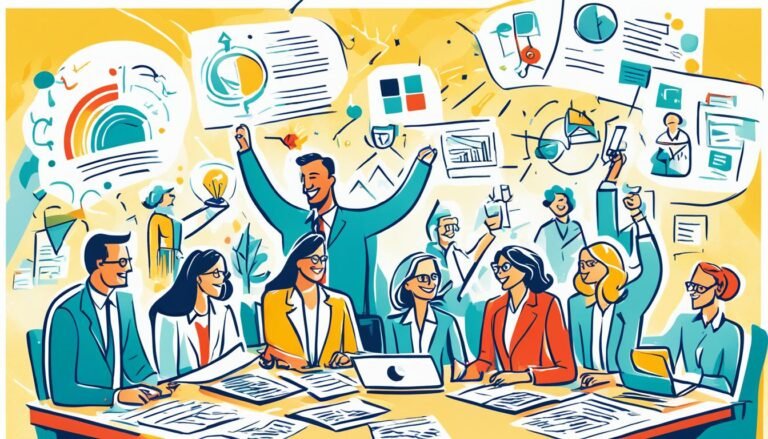Leadership in Media: Shaping Perspectives
“The media’s the most powerful entity on earth. They have the power to make the innocent guilty and to make the guilty innocent, and that’s power. Because they control the minds of the masses.” – Malcolm X
Media greatly influences our society. It shapes our views, sets industry trends, and changes our idea of leadership. Whether through traditional news or social media, media powerfully affects us. It influences our thoughts, stirs our opinions, and pushes for social change. The influence media has on us is huge and significant.
We’ll examine how leadership and media connect in this article. Media outlets must offer real, fair news. They should highlight good leadership, shed light on important issues, and promote honesty and fairness. Media can also question what we think is normal. Let’s see how media’s choices, like which stories to tell and how to tell them, can sway our opinions. This is especially important to consider when talking about women in leadership, business, politics, and society overall.
It’s crucial we learn to think clearly about the media we see. We need to get how media spin affects us and learn to choose wisely. We’ll also talk about fighting media bias and helping women get leadership roles in media. We’ll look at what the future holds for media and leadership with all the new tech.
We invite you to come along with us. Learn more about how media shapes our viewing of leadership today. This will be a deep dive into the impact, hurdles, and chances brought by media on our view of leadership now.
Key Takeaways:
- The media wields immense power in shaping perspectives and controlling public opinion.
- Media outlets have a responsibility to provide accurate and unbiased information, promote positive leadership qualities, and challenge societal norms.
- Media bias and selective reporting influence public opinion and can impact leadership perceptions.
- Overcoming media bias requires media literacy and critical evaluation of information.
- Empowering women in media leadership is essential for diversity and gender equality.
The Influence of Media on Public Opinion
The media is key to forming how we think and view the world. It uses special techniques to guide our attention and shape the way we see different topics. We’ll look into how the media does this and how it affects what we think.
Agenda-Setting
The media helps set what is ‘talked about’ in society through agenda-setting. By focusing on certain topics a lot, it tells us what’s important. A good example is talking a lot about climate change, which can make more people notice it and think about it more.
Selective Reporting
What the media chooses to share and how it’s presented can strongly affect our views. It creates a storyline about a topic or group. But this can sometimes be one-sided. It’s up to us to question what we’re told and think critically about it.
Framing
Media framing is how news stories are told to guide our understanding. It uses words, images, and context to highlight some parts of the story and hide others. An example is calling an economic policy a “stimulus package” or a “bailout” can lead us to feel differently about it.
“The media has the power to shape the conversation around certain topics and sway public opinion in favor of specific candidates or political parties.”
Think about how the media covers political campaigns. This coverage can really influence how we see politicians, affecting election outcomes. What the media says about the candidates can push us towards certain choices.
It’s very important to be mindful of how much the media can influence us. By thinking critically about what we’re told, we can stand against being led in one direction by the media. This helps us make choices based on real facts, not just what we’re told.
| Key Points | Examples |
|---|---|
| Agenda-setting | Media coverage influencing public awareness of climate change |
| Selective reporting | Media bias shaping public perception of political candidates |
| Framing | Language and context influencing public interpretation of economic policies |
Knowing how the media affects public opinions helps us be smarter about what we believe. By looking at information from different angles and sources, we can understand complex issues better. This way, we make choices that are well-informed.
Media Bias and Women’s Leadership
Media bias impacts How people see women in charge. It often shows them in a bad light. Female leaders are often judged for their looks, their behavior, and even their families.
This can make women less likely to go for leadership roles. It holds them back from growing in their careers.
Studies show it’s not just about personal looks. It influences business, too. When a company has a woman as its boss, the stock may go up and down because of how the media talks about her.
This can reduce the value of what female leaders do. It also sets up more challenges for women who want to lead.
The problem doesn’t stop with the work world. The media also criticizes women on having kids. Men usually don’t face the same pressure. This shows and supports old ideas about what men and women should do.
Getting past media bias is key for women to do well in leadership. It means letting women speak out about their lives and experiences. We should look at many media sources that show a fair view of everyone. And we need to talk about and change the biases in media.
“Media bias can create a distorted image of women in leadership, discouraging aspiring female leaders and inhibiting their progress. It is essential to break free from these biases and create a fair and inclusive environment for women to succeed.”
Infographic: Media Bias and Women’s Leadership
| Impact of Media Bias on Women’s Leadership | Strategies to Overcome Media Bias |
|---|---|
| 1. Reinforces negative stereotypes | 1. Promote diversity and gender equality in media |
| 2. Deters women from pursuing leadership roles | 2. Encourage women’s representation in media leadership |
| 3. Affects stock prices for companies with female CEOs | 3. Consume diverse media sources for balanced representation |
| 4. Creates additional barriers for women in leadership | 4. Give women a platform to share their stories and experiences |
Beating media bias in women’s leadership needs everyone’s work. Raising awareness and fighting unfair treatments can make a difference. With these efforts, we can build a world where all women have a fair shot at leading.
Media Bias and Leadership Perception
Media bias deeply affects how we see leaders. The way media shows leaders can change how we view their traits and qualities. This influences how we judge and support them in their positions.
The role of media in shaping leadership views is key. Outlets affect public opinion by what they say about leaders and their deeds. They can shape our view with the tone they use, positive or negative.
“Leadership is not just about inherent qualities or capabilities; it is also heavily influenced by the lens through which it is perceived.”
Media bias often leads to leadership stereotypes, particularly for women. Female leaders face unfair judgment because of this. It can discourage others from leading, narrowing leaders’ diversity.
The Influence of Media Manipulation
Media manipulation can change how we see leaders by focusing on some aspects and ignoring others. This can make people unfairly judge leaders. It has a lasting effect on how they are able to lead.
Spotting and fighting media bias is vital for a just appraisal of leaders. By demanding more diverse and fair media, our ideas of leadership can become broader and more accurate.
Overcoming Leadership Stereotypes
We need everyone to challenge these stereotypes, both the media and the public. Media should aim for fairness in their leader depictions and avoid promoting stereotypes.
Consumers must learn to spot bias and question what they see. Also, giving support to leaders from all walks of life helps fight these negative stereotypes.
The Importance of Media Influence
Media is crucial in shaping how we think of leaders and leadership. It’s important to deal with bias for a just society. Aiming for fair media and challenging stereotypes can make leadership more inclusive.
Media Bias and Business Leadership
Media bias affects business leadership, especially for women. How the media covers female CEOs can make investors react poorly, hurting stock prices. There’s often bias and speculation on appearance, attitudes, and family. This can make it hard for women to lead well.
Gender bias in business is worsened by media bias. Women leaders face unfair scrutiny, unlike their male counterparts. The media often focuses on women balancing parenthood and their jobs, while men escape these questions.
“Media bias can prevent women from receiving the recognition they deserve and hinder their progress in the business world.”
We must fight media bias in business leadership. This means giving women fair chances and questioning gender stereotypes that media bias supports. We should celebrate women’s achievements and know their views enrich the business world.
Addressing Media Bias in Business Leadership
Here’s what we can do about media bias in leadership:
- Educating people about media bias and its effects.
- Urging critical assessment of bias in media.
- Backing diverse media representation, including women leaders.
- Actively fighting gender stereotypes by being careful of what media we consume.
- Promoting media literacy to improve spotting trustworthy sources.
| Media Bias | Effects on Business Leadership |
|---|---|
| Negative portrayal of female CEOs | Negative reactions from investors, affecting stock prices |
| Bias and speculation about appearance, attitudes, and family life | Hindrance to effective leadership |
| Scrutiny of parenthood in leadership | Unfair expectations and questions about work-life balance |
| Challenge gender stereotypes | Promote diversity and inclusivity in business leadership |
Getting past media bias in business leadership is key for a fairer, better support for leaders of all genders.
Media Bias and Politics
Media bias greatly influences politics and democracy. How the media covers political events shapes what voters think. This can even change who wins elections. So, it’s very important to notice and deal with media bias.
When the media is biased, it can make politics very divided. People only see news that agrees with what they already think. This makes it hard to talk about different ideas and make things better. We need to understand how media bias affects us and try to have a fair and open political world.
“The more you can increase fear of drugs, crime, welfare mothers, immigrants, and aliens, the more you control all the people.” – Noam Chomsky
The Role of Media in Election Results
Media outlets can really change election results. They can make people like certain candidates more or less. This happens when the news is not fair or when it only talks about some things and not others.
Studying the news lets us see how it affects election outcomes. How much a topic is discussed, the way they talk about candidates, and which ideas are popular all impact what voters think.
The Polarizing Effect of Media Bias
Media bias can pull us apart politically. If the media only agrees with one side, it makes people from different groups not want to work together. This makes it difficult for politicians to agree and move forward together.
To make democracy stronger, we should encourage fair and balanced news. This would create an environment where everyone’s ideas are listened to and respected.
Addressing Media Bias in Politics
Fighting media bias needs efforts from different sides. Media should promise to be truthful and fair when they report. This means they must try to only share the facts without their own opinions.
But, people watching and reading news also have a job to do. Learning to be smart about what we see and hear can help us see through biases. Looking for news from many places can also decrease bias’s influence on us.
Media Bias and Its Impact on Politics
| Impact of Media Bias on Politics | Explanation |
|---|---|
| Influence on Voter Perceptions | Media coverage of political campaigns can shape voter’s views on candidates and their ideas. |
| Polarization of Political Discourse | Media bias can make politics very divided, making it hard for different groups to work together. |
| Impact on Election Results | Biased media can make people like one candidate or party more, changing who wins elections. |
| Need for Media Literacy | It’s critical to spot and question bias in the news for smart political decisions. |
The Impact of Media Bias on Society
Media bias greatly influences how people see the world. It does this through sensationalized stories that twist the truth. These stories focus on the shocking to grab attention but often miss the real point.
This twisted reporting can give us wrong ideas about events and even people. It makes our view of the world lopsided. So, it’s crucial to not believe everything we hear without checking the facts.
In today’s world, fake news is a huge problem. False stories spread fast and can change how we think. They can even make us scared or angry. It’s important to look for news from sources we trust and to question what we read.
Media stories can make us feel afraid, anxious, or panicked, especially when they only focus on bad news. This can make us overestimate how bad things really are. It’s key to be smart about what we believe and to look for news that shows the bigger picture.
However, the media can do good things too. It can point out important issues and get people talking about how to fix them. Stories about people helping each other or making progress can inspire us to join in. They show us ways we can all make the world better.
“The media’s power to shape public opinion is immense. It is imperative that media outlets take their responsibility seriously and strive to present objective and unbiased information to the public.”
In the end, media bias has a big impact on our society. It can spread negative lies, but it can also inspire positive changes. To make the most of the media, we need to think carefully about what we see and read. It’s up to us to choose news wisely and to look for stories that show the whole truth.
Overcoming Media Bias
To beat media bias, we must get good at understanding the media and checking what they say. This way, we can have our own fair and well-informed opinions on important topics. This skill is key when looking at what the news says about leaders or big issues.
Media literacy means knowing some sources might not tell the whole truth. We should look at news from different places to really understand a story. This helps us find the real truth behind the news and not get caught up in just one view.
“Media literacy involves being aware of biases present in different media sources and actively seeking out diverse perspectives.”
Being able to look closely at what the news says is very important. We should always ask where this info comes from and if it can be trusted. This way, we can tell the true facts from what people might just think.
Talking about news in places where everyone can share their view is also a great idea. It helps us see things from different sides and learn from others. This can open our minds and make us see things more clearly.
Tips for Overcoming Media Bias
| Tip | Description |
|---|---|
| 1 | Consume diverse media sources |
| 2 | Question sources and assess credibility |
| 3 | Seek out different perspectives |
| 4 | Engage in critical evaluation of content |
| 5 | Participate in unbiased discussions |
Spotting and knowing media bias is the first step to stop its negative effect. It is crucial to keep learning about the media and always check if the news is really true. By doing this, we get better at understanding what’s going on in the world.
Empowering Women in Media Leadership
Empowering women in media leadership matters a lot. It helps bring in more diversity and equality. It also supports telling stories that include everyone. By giving women more chances and a louder voice, we beat the bias and old stories in media.
But, too few women lead in media. This problem means women can’t grow as much at work. It also shapes the stories we hear in a not-so-fair way. Helping women to take charge in media means we get a more fair and equal media world.
We need to make a place where women can lead well. This means we have to fight against ideas we don’t even know we have. We need rules that treat men and women fairly. And we should help women find mentors and friends who can help them lead.
Also, talking about women who lead well is important. It shows girls they can lead, too. Seeing all kinds of women doing great helps us see that anyone can lead, not just a few.
Driving Gender Equality
Letting women lead in media is more than just having them there. It changes how decisions are made in a more open way. We get to see things from different sides.
Media really shapes how we think and act. Showing us strong women leaders and not sticking to old ideas helps. It makes our society more fair and better for everyone.
“Empowering women in media leadership is not just about gender equality; it’s about untapping a vast pool of untapped talent and diversifying perspectives.” – Jane Smith, CEO of Media Empowerment Initiative
Breaking Stereotypes and Amplifying Voices
Women who lead in media often face big challenges. People sometimes don’t believe they can do well. They may not see many chances to get ahead. But we can change this by letting women lead.
When women lead in media, they can talk about big issues. They can make sure we hear from groups we don’t hear enough. This makes the stories we hear real and full of different voices. It helps us understand more about each other.
Statistics on Women in Media Leadership
| Category | Percentage of Women |
|---|---|
| CEOs of Major Media Companies | 27% |
| TV News Industry Executives | 35% |
| Film Directors | 16% |
| Editors-in-Chief | 32% |
Letting women lead more changes our media for the better. Giving women the same chances and tearing down old walls opens the door for a media that’s fair, diverse, and equal.
The Future of Media and Leadership
The world is changing fast, thanks to technology and digital growth. The future of how we see media and leadership is also changing. As technology shapes our media world, leaders need to pick up new ways to reach out and connect with people.
Social media is a big part of leadership today and will stay that way. Facebook, Twitter, and LinkedIn have changed how leaders talk to people. They let leaders share their views and plans right away with everyone, no matter where they are. But, leading on social media means being careful, honest, and fair.
“The future of media and leadership lies in leveraging technology to build strong connections and foster meaningful dialogues with the audience.”
Knowing how the media world is changing is key for leaders to do well. Old ways of media, like TV and newspapers, are having a hard time in our digital world. On the other hand, online shows, podcasts, and interactive stuff are getting more popular. Leaders must check out and adjust to these new ways to reach people well.
Tech changes also ask for more responsibility and fair play from the media and leaders. With fake stories and biased news on the rise, being right and honest with information is crucial. Teaching media skills and checking news sources right are needed. This helps people sort through the many stories out there and make smart choices.

New tech offers leadership in media cool chances to connect with their audience. Things like AI, data looking, and machine learning help leaders know their audience better, make personal content, and send messages that fit just right. Using new tech this way means leaders can make stronger bonds with their followers.
In closing, the media and leadership’s future is already being shaped by tech and a changing media world. Leaders who learn, use new tech to be better, act responsibly and fairly, will do well. By staying up with how media is changing, leaders can influence, change for the better, and really connect with people in the years to come.
Media Literacy and Responsible Consumption
Media literacy is key in our digital world. It helps people use media wisely and think critically. With so much info around, it’s vital to check where it’s coming from. This way, we can all make smart choices and be active in our communities.
Critical thinking and media literacy go hand in hand. It means not just believing what you see or hear. You ask questions, look at different angles, and figure out what’s true and what’s someone’s opinion.
“Media literacy empowers individuals to discern reliable sources, identify biases, and engage in constructive dialogue.”
Knowing if a source is trustworthy is very important. When we look at the who and where of information, we can guess how true it might be. It’s also good to check more than one source to get the full picture.
Being smart about what media we take in matters a lot. It affects how we feel, what we think, and do. By being careful with what we watch and read, we can avoid falling for stuff that’s not true.
Teaching media literacy is a big deal. Schools and communities are getting better at helping everyone understand the media. They teach us how to check what we see, spot bias, and know media’s role in our lives.
The Benefits of Media Literacy:
- Enhanced critical thinking skills
- Ability to differentiate between reliable and unreliable sources
- Greater awareness of media bias and its impact
- Empowerment to challenge misconceptions and misinformation
- Active engagement in constructive dialogue
We build a better society when we understand and use media wisely. Media literacy makes us strong, smart citizens.
Conclusion
Media leadership shapes our society through opinions and stories. We must understand and fight media bias, especially for women to lead. Empowering women in media and pushing for diversity helps our society thrive with many viewpoints.
Being able to understand media and think critically is crucial. We should check sources for truth and bias. This helps us to make smart choices and fully engage in our communities. As tech changes, the link between media and leadership will too, showing the need for fair and open leadership.
Working together, we aim for a future where media leadership is a force for good. It should fight bias, uplift women’s voices, and make the world fairer and more open to all.
FAQ
What is the role of media in shaping leadership?
Media helps shape leadership by influencing what people think, showing what good leaders do, and making sure leaders are responsible for their actions.
How does media influence public opinion?
Media can set the agenda, choose what to focus on, and shape stories in a certain way. This affects how the public feels about topics or leaders.
How does media bias impact women’s leadership?
It can be harder for women to lead because the media might use unfair ideas about them. This includes judging their looks and family instead of their skills.
Does media bias affect how leaders are perceived?
Yes, media bias can change how people see leaders. It can change which qualities we think are important for leaders to have.
How does media bias impact business leadership?
Unfair media can make it tough for women leading in business. They might face negative views from investors due to focus on irrelevant things like how they look or their personal life.
What are the implications of media bias on politics?
Bias in political media can shape how people see politicians. It can make the political scene more divided and affect who wins in elections.
How does media bias impact society?
Media bias can twist the truth, keep up harmful ideas, spread false information, and make people more scared and worried.
How can we overcome media bias?
Beating media bias needs us to know how to watch out for it, check the news carefully, see different sources, and talk about news fairly.
Why is empowering women in media leadership important?
Having more women as leaders in the media makes the stories we hear more fair and varied. It helps fight bias and shows different views.
How will the future of media and leadership evolve?
As tech keeps getting better, media and leadership will change more. We will need leaders who are fair and bring everyone into the conversation. They will help make sure the media shows a wide range of voices and stories.
Why is media literacy important for responsible consumption?
Understanding the media helps us think critically, check if news is true, and be a part of society by making choices based on good information.
What is the importance of media leadership and overcoming bias?
Media leaders really can make a difference by showing things in new ways, affecting what people think, and setting trends. Beating bias helps make sure everyone is treated fairly and makes smart decisions based on the true story.
Source Links
- https://medium.com/@johniewawesh/media-and-leadership-media-plays-a-major-role-in-shaping-leadership-and-influencing-public-opinion-1a31d4a24b53
- https://englishpluspodcast.com/the-power-of-media-how-it-shapes-public-opinion-and-society/
- https://www.womleadmag.com/what-is-media-bias-and-how-does-it-affect-womens-leadership/








